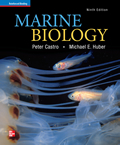1 A) wave-swept rocks at high tide B) A deep pool at low tide C) A muddy bay with low oxygen in the sediment D) A flat sandy beach in a bay 2 A) Louisiana B) Virginia C) Washington D) Vermont 3 desiccation by all of these means except which one?A) Avoiding the hot sun by moving or growing in damp crevices B) Sealing up shells and over coverings to prevent water loss C) Being able to tolerate losing up to 90% of the body water D) Having brown shells 4 spring tide.A) True B) False 5 A) True B) False 6 A) True B) False 7 A) True B) False 8 A) Grazing snails do not range into the highest tidal levels. B) The animals of the upper intertidal zone cannot survive total emersion in seawater. C) The water in the pools can evaporate, making the pools hypersaline and anoxic. D) Nothing consumes bacteria. 9 A) A chiton that lives on the surface of rocks B) A mussel living in surf-swept areas C) A crab that retreats into a burrow D) A limpet that lives under algae 10 A) Quiet pool with much sediment B) Ocean-facing mid-tidal rock C) Upper part of a surf-swept cliff D) Under seaweeds 11 A) Having more larval stages. B) Shading them so that the competing species cannot carry on photosynthesis. C) Attaching to them. D) Being able to tolerate harsher environmental conditions. 12 A) The beach surf zone B) The mudflats C) The lower rocky intertidal zone. D) The salt marsh. 13 A) True B) False 14 A) True B) False 15 A) Barnacle. B) Starfish. C) Periwinkle. D) Soft-shelled clam. 16 A) Strong anchorage system B) Low body profile C) Suction cup D) Tolerance of low oxygen levels 17 A) Mussels, by reducing the number of algal competitors. B) Lobsters, by reducing the numbers of mussels. C) Barnacles, by reducing the numbers of dog whelks. D) Periwinkles, by reducing the numbers of unicorn snails. 18 A) On dune plants. B) On diatoms. C) By scavenging. D) By filtering the water at high tide. 19 A) Filter feeding with their siphons and gills. B) Producing a mucus net. C) Spreading the tentacles on the bottom and catching particles there. D) Pumping water through siphons. 20 A) Warning coloration B) It's nocturnal C) It contains hemoglobin D) Mate attraction 21 A) There are high bacteria levels. B) The substrate is constantly shifting due to wave and tidal actions. C) The water conditions are always anoxic. D) They are subjected to extremes of water pressure. 22 A) Epifauna B) Sessile C) keystone predators D) Infauna 23 A) Blue crab B) Sand dollar C) Ghost crab D) Moon snail 24 A) True B) False 25 A) True B) False 26 Littorina ) often dominate the upper rocky intertidal because they can breathe air and tolerate extremes of temperature.A) True B) False 27 A) Special feeding appendages B) Burrowing mechanisms C) Special hemoglobin D) Hard exoskeletons 28 A) True B) False 29 A) Bottoms covered with fine silty mud B) Bottoms covered with course sand and gravel C) Bottoms covered with large masses of encrusting coralline algae D) Large wave rounded boulders 30 A) A very soft fine sediment B) A course sandy sediment C) The presence of anaerobic bacteria and low oxygen D) High grazing rates by periwinkle snails 31 A) Mantle B) Gill C) Shell D) Foot 32 A) True B) False 33 A) Immersion B) Subsiding coastlines C) Substrate D) An active continental margin.





